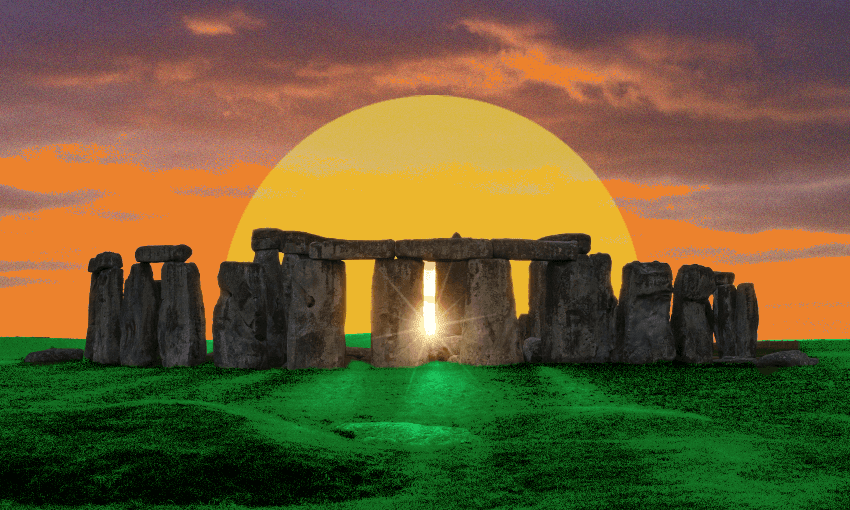A new exhibition at Auckland Museum takes a deep look at one of the planet’s most mysterious human-made sites. James Borrowdale met the man responsible for sharing Stonehenge’s secrets with Tāmaki Makaurau.
We were standing inside Auckland Museum, which Professor Mike Parker Pearson noted held many similarities to Stonehenge – both structures built to memorialise the dead, out of stones carted from afar. “I don’t think I’ve ever been in any building of the modern age which is effectively such a close comparison.”
Parker Pearson, Professor of British Later Prehistory at University College London and the curator of the Secrets of Stonehenge exhibition now on display at Auckland Museum, is a world-leading authority on the much-mythologised structure. He has devoted the past 25 years of his scholarly life to diminishing the mysteries that surround it. As we walked through the exhibition, under screens of televised Parker Pearsons and artefacts shining light on the people who built Stonehenge, his conversation momentarily resurrected those ancient lives. He spoke to me of their motivations, the world as it appeared to them, and why the circle of stone they built still fascinates us 5,000 years later.
Borrowdale: Can you set the scene for the building of Stonehenge?
Parker Pearson: We’re talking about a period that takes us back to 5,000 years ago when they built the first Stonehenge. But of course, there’s a whole sequence before then from the ending of the Ice Age, when you’ve got hunter-gatherer populations living in Britain. Around 4000 BC, they are basically replaced by farmers whose ancestors have moved from Europe and all the way back to the Middle East.
These are completely new populations bringing in entirely new agricultural technology, domesticated animals and plants; barley and wheat and so on. And the hunter-gatherers disappear, just like that, probably within a couple of centuries. Then 1,000 years later, in 3000 BC, these farmers built the very first Stonehenge.
And why here, on the Salisbury Plain?
Close to where Stonehenge would be built, in around 8000 BC to 7000 BC the hunter-gatherers put up a whole series of giant posts. It’s unusual for hunter-gatherers to build monuments. So it’s an exception, and there was also a major base camp for those hunter-gatherers just down by the river.
With the early farmers, in the 700 years before Stonehenge, this had become a sacred landscape of burial mounds, in particular, but also more of these gathering sites. The avenue leading out of Stonehenge was actually built on top of an existing landform, which was entirely natural, formed in a previous Ice Age, where the line in the land, which would have been visible as a linear feature, happened to coincide with where the sun rose at midsummer and where it set at midwinter. So Stonehenge is not plunked in the middle of nowhere – it’s already somewhere very special. I think they must have thought that this was the centre of the world. This was the origin point of everything.
That first Stonehenge – not the more-recognisable lintel-topped stones later quarried from a local location – is of particular interest for you. Why?
It’s quite a simple arrangement. It’s just a circle of relatively small stones. But it’s interesting because instead of finding something local, they get these from 280 kilometres away. From another ceremonial complex.
Why would they transport these enormously heavy stones all that way?
What’s really interesting is to try and get our minds into a society that doesn’t have the valuables that we take for granted today, gold and silver and other precious things. It’s realising that stone had a significance, and they’re prepared to put these megalithic stones – anywhere up to four tonnes – in their luggage and bring them 280 kilometres from the coast of Wales. They’re basically moving elements of somebody’s ceremonial landscape and putting them into a new one. And that just shows us how important the stones were. They have to have been emblems of identity and ancestry, so it’s like taking your ancestors with you. The other possibility is that you could have your ancestors captured, and that these are actually trophies that have been brought to this place.
The evidence at the moment suggests the former, that people are bringing them with them, because we’ve done the science on the people buried at Stonehenge at this time and a number of them in the previous 10 years of their life, had been living in a geology that would be compatible with that part of Wales. The evidence for human occupation in that part of Wales, it sort of falls off a cliff after 3000 BC, and we suspect they may have come with their stones and migrated out of there. But at the moment, it’s just a hypothesis.
And how did they move them? You tend to discount the by-sea theory?
That was put forward almost 100 years ago now by archaeologist Richard Atkinson who had experiments done with punts and all the rest of it. The thing that works in its favour as a theory is that these Neolithic farmers, before their arrival in Britain, their ancestors had been sailing boats throughout the Mediterranean. So they’re coming with 2,000 years of maritime experience. What counts against it is that the quarries in the stone circle sites we found are on the north side of the Preseli Range. So you’d have to go over that ridge just to even start. And there’s an easy land route which follows the valleys of South Wales.
And we now know the exact spots from which these rocks were originally quarried.
So where I’m standing in this photo [above] at Carn Goedog there’s one, two, three pillars that are missing. I’m standing at the foot of where they would have been pulled out. And at the other quarry, Craig Rhos-y-felin, the geologists could actually say exactly which pillar had gone to Stonehenge because they found out that the microstructure of the rhyolite varied across the face of the quarry. There is one pillar that next to it has still got the stone wedges used to lever them out. They were going to remove that one and gave up.
The amount we have learned in the past 20 years, through you and your colleagues’ work, about Stonehenge has increased dramatically. And Secrets of Stonehenge is the result of that work. Can you tell me about the background to the recent scholarship, and some of the most significant discoveries?
There was a key moment in the first decade of the 21st century, when all of the excavations had been finally written up from the previous 100 years. Because, unfortunately, the people who had dug at Stonehenge had failed to write a decent account. Life got in the way, I suppose. And so by the end of the 20th century, we’d actually got some dates for Stonehenge. But we hadn’t quite got the sequence itself properly worked out. We were lucky because that was the point at which everything had been rounded off. A new era of discovery could begin. Until that point, our government, through the ancient monuments and heritage bodies, didn’t want anyone doing more work while there was unpublished work still languishing. So we hit it just at that point. It was the impetus given by my having worked in Madagascar with [Malagasy archaeologist] Ramilisonina and him coming to Britain in 1998 that was just the spark that lit the fuse. Little did I know that that would keep me busy for the next quarter century through to now.
I think one of the greatest things was realising that we did indeed have a domain of the living at Durrington Walls [a Neolithic settlement close to Stonehenge], the discovery of houses with perfectly preserved floors, which had miraculously escaped to being destroyed by ploughing in the last few thousand years. I could see the holes where their knees had been as they were building the fire and cooking the food on it. These were houses with beds and furniture, and we can see the internal layout of where the furniture had been, just like the houses we’re finding in other parts of Britain that we recognise as being family households. That immediately shows us that this wasn’t a work camp just for men. This is men, women, children – entire communities. And realising that they were just dividing up that landscape, there was one place where they were living, and there was another place where the dead had been buried within the stone circles.
Why do you think Stonehenge remains such a potent cultural symbol?
In many ways, that’s the most mysterious thing of all. Why does it just grab the human psyche? It’s been used to advertise everything from Boeing jet engines to cigarettes to electric cars. It is quite baffling. When I think back to childhood, there is this moment that I think really leads to it taking off, when we’re just going into the pop festival world culture, with Woodstock and the Isle of Wight Festival. In the early 70s, the Stonehenge Free Festival started. It becomes the focus of a huge nationwide counterculture – people looking for new spirituality, new ways of living, that are outside of the constraints of normal society, and Stonehenge really encapsulates that for many of them. And, of course, that all comes crashing down in 1985 with the Battle of the Beanfield [when police enacted a High Court injunction on the festival taking place] and we have over 500 arrests, the greatest number of civil arrests in Britain since the Second World War. But the counterculture keeps going, we get new groups of radical druids who have adopted Stonehenge as their temple. And so even though access is curtailed, right up until this current millennium, this current century, it’s still there as a potent symbol.
What will people gain by visiting Secrets of Stonehenge?
It’s the first time we’ve really seen the human side of Stonehenge. It’s about actually making them people again, and sharing the other half of life, you know, beyond the megaliths, the domain of the living as opposed to the domain of the ancestors. It’s about getting people to understand what such societies were like, what it must have been like to live in a society where ancestors were so massively important. For those that are indigenous to New Zealand, that’s easier to understand. Harder, I think, if you have Western ancestry, where you don’t come with that understanding of your place in the universe.

